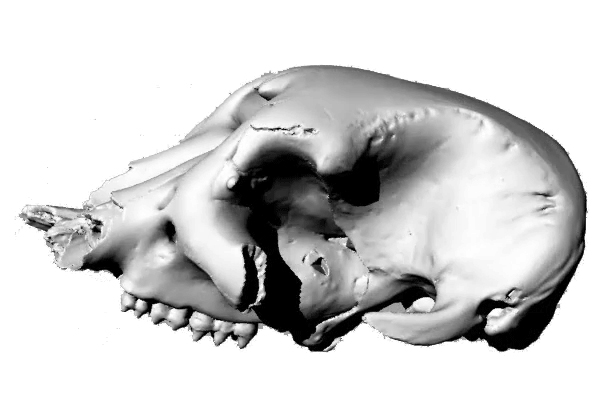3D Scanned Skulls from the Virtual Curation Laboratory

Showing through April, in the evening.
The Cabell Screen features models of skulls 3-D scanned by Bernard Means, Ph.D., an anthropology professor in the School of World Studies in the College of Humanities and Sciences. Dr. Means is the director of the Virtual Curation Laboratory, which specializes in the 3D scanning and 3D printing of historic and archaeological objects, including many notable artifacts from museums across Virginia and around the world. He frequently works with museums to 3D scan fossils in their collection for preservation and to 3D print replicas.
The 14 skulls featured on the Cabell Screen range from prehistoric mammals to modern birds. One scan is a 37 million-year-old oreodont skull originally found in the Pine Ridge Indian Reservation in South Dakota. Prehistoric oreodonts may have been distantly related to modern pigs and hippopotamuses. Also included is a baby mastodon skull dating from the Ice Age, which was found in the Carter Bog site in Ohio. Mastodons, which are extinct along with oreodonts, are distantly related to modern elephants. The show also includes modern beavers, crow, deer, and raccoon skulls, among others.
The skulls in order of appearance on the screen are:
- Modern raccoon from California
- Modern groundhog with fractured cheek bone from George Washington’s Ferry Farm
- Modern beaver provided by Rusty Nix of the Virginia World War I and II Commission
- 37 million-year-old oreodont from the Pine Ridge Indian Reservation in South Dakota, courtesy of the Western Science Center
- Modern deer skull, broken
- Rhynchotherium, an extinct relative of the elephant, found in Arizona. Most complete specimen ever found, courtesy of the Las Vegas Natural History Museum
- Modern crow, donated to the Virtual Curation Laboratory by a VCU student
- Dog, from a dog burial at an Native American village archaeological site in Maryland, dating to circa 1300 A.D.
- Modern beaver cranium from the Virginia Museum of Natural History
- Modern coyote found and donated by VCU alumnae Laura Nixon
- Ice Age camelops, from southern California. Nose was ripped off by a bear. Courtesy of the Western Science Center
- Dog, from a late 19th/early 20th century dog burial in Gloucester, Virginia. Courtesy of the Fairfield Foundation
- Modern barred owl from the Virginia Museum of Natural History
- Modern guinea pig
- Ice Age baby mastodon from the Carter Bog site in Ohio. Courtesy of Boonshoft Museum of Discovery, Dayton (above right)